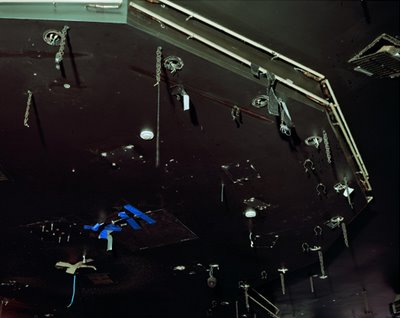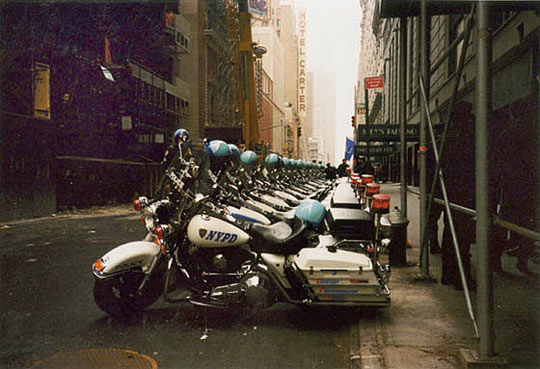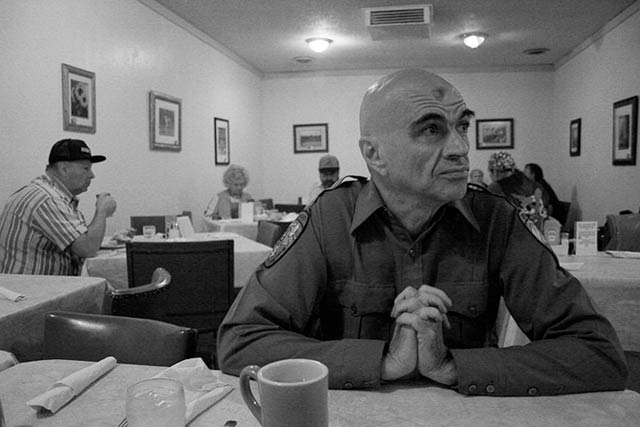
…and it may be that the immobility, the inertia, the absence of all active passion or incident or peril which such a retired existence imposed upon man led him to create, in the midst of the world of nature, another and an impossible world, in which he found comfort and relief for his idle intellect, explanations of the more ordinary sequences of events, and extraneous solutions of extraordinary phenomena. (…)
…for him the legend confounded itself with life, and, unconsciously, he found himself regretting that the legend differed from life, and that life differed from the legend.
{ Ivan Goncharov, Oblomov, 1859 | Continue reading }
{ uncredited photo | any thought? }
books, ideas, photogs |
March 23rd, 2010

Black holes may constitute all dark matter
Dark matter is the mysterious stuff that cosmologists believe fills our Universe. The evidence for its existence is that there is not enough visible mass to hold galaxies together. But since galaxies manifestly do not fly apart, there must be some invisible stuff, some missing mass, that generates the gravitational forces holding them together.
But there’s a problem with this idea. Two of them actually. First, physicists’ best guess at the laws of physics give a good description of all of the particles they’ve discovered so far and a few they expect to discover soon. The trouble is that none of these particles have the right kind of properties to be dark matter ie electrically neutral, long-lived and slow moving. But none of the known or reasonably hypothesised particles fits the bill. To make room for a dark matter particle, the laws of physics have to be changed in ways that many theorists feel uncomfortable with.
Second, despite a decade spent searching for dark matter with experiments costing tens of millions of dollars, nobody has laid eyes on the stuff. Most physicists think these experiments have found nothing: zip, zilch, zero.
{ The Physics arXiv Blog | Continue reading }
photo { Nick Waplington, S-M Club Ceiling, 2004 }
science, space, uh oh |
March 23rd, 2010
new york, photogs |
March 23rd, 2010

Religious architecture and art were to medieval feudalism what advertising and commercialism are to modern capitalism: A rather effective way to build support for the status quo using aesthetics instead of argument. My claim, in short, is that Notre Dame played the same role during the Middle Ages that fashion magazines play today. Notre Dame was not an argument for feudalism, and Elle is not an argument for capitalism. But both are powerful ways to make regular people buy into the system.
{ EconLog | Continue reading }
art, ideas |
March 23rd, 2010

In any case, suffering is not something to be sought, but, since it is unavoidable, when one does encounter it, one must learn to use it for good. The person who has gone through suffering, and emerges better from the experience, is strengthened but it was not the suffering but the person’s own moral fibre that made them better.
{ Peter Bolton | Continue reading }
Take psychic suffering first of all. Severe depression is one of the most acute forms of pain known to humanity. Those who have suffered from both depression and serious physical illness are almost unanimous in agreeing that the depression is worse. Does this make them better people? Certainly not at the time. I’ve seen depression close up with several people, and one of them hit the nail on the head when they said that depression makes you really selfish. You can see that it’s taking its toll on people close to you, but you are just too self-absorbed to change how you treat them.
Are they better having come through the depression? I see no evidence for this, I’m afraid.
{ Julian Baggini | Continue reading | More: Does suffering improve us? | The Guardian }
photo { Shane Lavalette }
health, ideas |
March 23rd, 2010

Tom Bissell was an acclaimed, prize-winning young writer. Then he started playing the video game Grand Theft Auto. For three years he has been cocaine addicted, sleep deprived and barely able to write a word. Any regrets? Absolutely none.
{ Tom Bissell | full story }
installation { Stephen Johnson, Ice Cream Floats, 2005-2007 }
drugs, experience, leisure |
March 23rd, 2010

it always makes me perplexed when people refuse eternal youth. […] ulysses: ‘i’m glad someone invented death.’
archives, celebs, imp, time |
March 23rd, 2010

Most people in most places simply won’t be able to find a toilet when they need one. And for women, the lack of decent facilities is more than a problem. It’s an emergency. Public conveniences are the final battleground in the sex wars, the ultimate declaration of discrimination. (…)
You may think of America as the country that created the allergy, where bathroom culture rules, where germs and dirt are feared more than global warming and where cleanliness is worshipped alongside godliness – but public conveniences in some of its major cities are a disgrace. New York City, for example, is one of the most sophisticated metropolises in the world. Yet its provision of any public toilets at all, let alone clean and decent ones, is woeful. (…)
Today, there are still far fewer public toilets for women than for men in many British cities, in terms of both the number of toilets available and the ratio of male to female facilities. But even if the numbers were more equal, that wouldn’t solve the problem, according to the American sociologist Harvey Molotch, because women suffer “special burdens of physical discomfort, social disadvantage, psychological anxiety” when in public.
{ New Humanist | Continue reading }
photo { Stephen Shore, New York City, New York,September-October 1972 }
economics, health, ideas |
March 23rd, 2010

Music does not express this or that particular and definite joy, this or that sorrow, or pain, or horror, or delight, or merriment, or peace of mind; but joy, sorrow, pain, horror, delight, merriment, peace of mind themselves, to a certain extent in the abstract, their essential nature, without accessories, and therefore without their motives. Yet we completely understand them in this extracted quintessence. (…)
Music, if regarded as an expression of the world, is in the highest degree a universal language, which is related indeed to the universality of concepts, much as they are related to the particular things. (…)
This deep relation which music has to the true nature of all things also explains the fact that suitable music played to any scene, action, event, or surrounding seems to disclose to us its most secret meaning, and appears as the most accurate and distinct commentary upon it. This is so truly the case, that whoever gives himself up entirely to the impressions of a symphony, seems to see all the possible events of the world take place in himself, yet if he neglects, he can find no likeness between the music and the things that passed before his mind.”
{ Arthur Schopenhauer, The World as Will and Representation, 1818 }
photo { Noritoshi Hirakawa }
ideas, music |
March 23rd, 2010

Founded in 1974 and based in Los Angeles, the Z Channel was the nation’s first pay-cable station, preceding HBO or Showtime. At its pinnacle in the early 1980s, it served only 100,000 viewers, but nonetheless inspired and influenced the movie industry with its eclectic fare, securing a unique place in film history.
{ Netflix }
The Z Channel was known for its devotion to the art of cinema due to the eclectic choice of films by the programming chief, Jerry Harvey. It also popularized the use of letterboxing on television, as well as showing ‘director’s cut’ versions of films (which is a term popularized after Z Channel’s showing of Heaven’s Gate). Z Channel’s devotion to cinema and choice of rare and important films had an important influence on such directors as Robert Altman, Quentin Tarantino, and Jim Jarmusch. In 1989, Z Channel faded to black and was replaced by SportsChannel Los Angeles.
{ Wikipedia | Continue reading }
photo { Otto Obrien }
flashback, showbiz |
March 23rd, 2010

{ The patterns of links between buyers and sellers of sex in an online forum differs in important ways from other internet related networks, says a new study. This may have important implications for the spread of sexually transmitted diseases | Patterns of Captured in Social Network | full story }
update/related { A top journalist caught on tape with a pile of cocaine and a party girl named Moomoo, an opposition activist filmed handing over a bribe… Who’s behind the spate of mysterious coke-and-hooker entrapment attacks on Russian opposition figures? The Daily Beast | full story }
economics, health, science, sex-oriented, social networks |
March 23rd, 2010

In 1968, The MPAA created the Classification and Ratings Administration (CARA) to designate films with one of four ratings: G (general audiences), M (mature audiences), R (children under sixteen years old not admitted without parent or guardian), and X (children under seventeen years old not admitted). Three years later M became PG (parental guidance suggested). In 1984, in response to violence in the movie Indiana Jones and the Temple of Doom, the film review board instituted the new PG-13 rating, which cautions parents that the film’s contents may be inappropriate for children under age thirteen. In 1990 the board responded to criticism that the X rating unfairly categorized artistic adult films, such as Midnight Cowboy, with hard-core pornography. In that year the board replaced X with NC-17.
In the movie business, a better rating is generally a lower rating. Movies typically make more money when they appeal to the widest possible audience. This rule holds true particularly with motion picture video sales. Many video outlets limit their inventory to movies with ratings no higher than PG-13 or R. Some theaters refuse to show movies with the NC-17 rating, and some newspapers refuse to carry advertisements for movies with the NC-17 rating. A movie studio therefore wants its film to earn the least restrictive rating possible.
One exception to this general rule is the marketing of pornographic films. Because studies have suggested that sexually explicit films become more desirable when they are restricted, the pornographic film industry voluntarily labels its films X or XXX in an effort to increase sales. XXX is a marketing tool, not an actual MPAA rating.
{ Answers | Continue reading }
economics, showbiz |
March 23rd, 2010

{ Norman Parkinson, Fairy, Brooklyn Bridge, 1949 }

{ Norman Parkinson, Wenda [Norman Parkinson’s wife], Times Square, 1949 }

{ Norman Parkinson, First Nude in Colour, ‘Vogue Beauty Book’, 1951 }

{Norman Parkinson, After Van Dongen, 1959 }

{ Norman Parkinson, Duchess of Seville, Apple and Horse, 1981 }

{ Norman Parkinson, Self-portrait with model, 1970s | Norman Parkinson died aged 76 in Singapore on February 15 1990, two weeks after suffering a cerebral haemorrhage, camera in hand. | Wikipedia | A new book celebrates the glamorous world of fashion photographer Norman Parkinson. }
photogs |
March 23rd, 2010

What makes a fruit “super?”
First of all, we have to define what characteristics a fruit has to have to be labeled “super.” The superfruit craze seems to have hit a tipping point in 2004, however there appear to be no clear standards as to how a fruit attains a “super” status. Marketing and exotic appeal rather than science have given select fruits a more salubrious appeal. As most health claims however, these are based on perception rather than evidence.
One thing that superfuits do have in common, however, is a high ORAC value.
The Oxygen Radical Absorbance Capacity (ORAC) assay was developed to directly test the antioxidant capacity of biological samples. There are however many different tests of antioxidant capacity that have been developed and utilized, each with various shortcomings.
{ Nutritional Blogma | Continue reading }
drawing { Ellsworth Kelly, Tangerine, 1964-65 }
Ellsworth Kelly, food, drinks, restaurants, health, science |
March 23rd, 2010
photogs |
March 23rd, 2010
books, economics, video |
March 23rd, 2010
climate, horror, water |
March 23rd, 2010




























